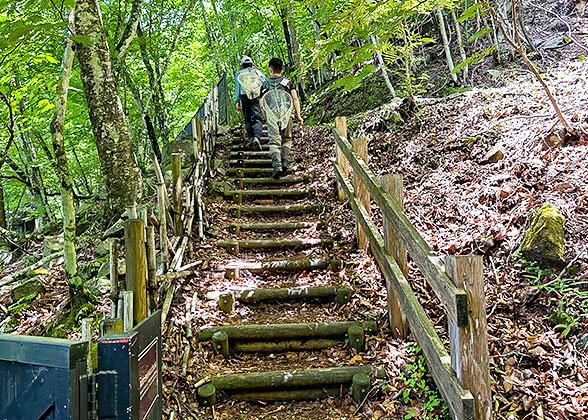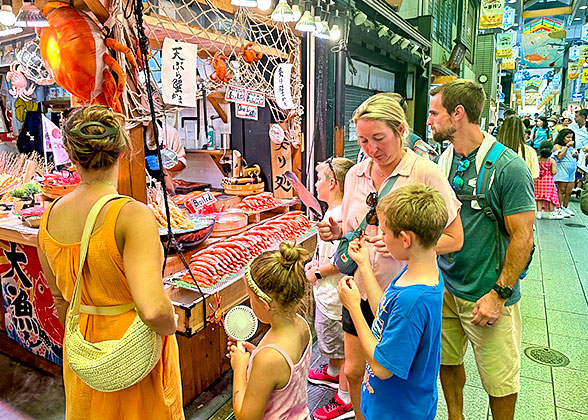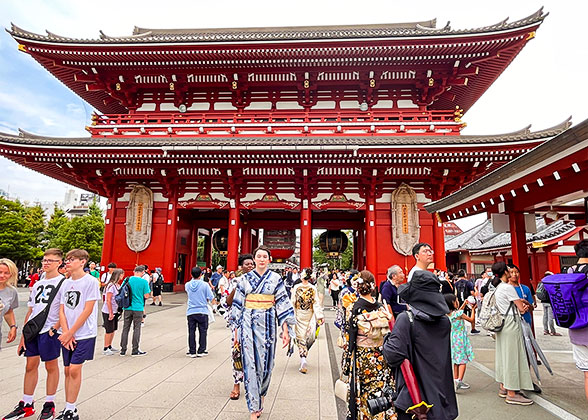Best Time to Visit Wakayama
When is the best time to visit Wakayama?

Hike in the Mountains
|
Firstly, during these times, Wakayama generally enjoys mild weather with moderate rainfall, and it is rarely affected by typhoons. Plus, the air is fresh and clean, free from stuffiness or chill, making it suitable for outdoor activities, like Kumano Kodo pilgrim routes hiking.
Secondly, breathtaking natural scenes unfold before your eyes. From late March to early April, the whole prefecture adorned with cherry blossoms, transports you to a dreamy pink fairyland for an instant. Kimiidera Temple, Wakayama Castle and Negoro-ji Temple are popular destinations for flower admiration. If you enjoy discovering hidden gems, Heisogen Park and Kishi Station are advised. During early November through early December, you have a chance to admire colorful autumn leaves. Where to enjoy them in urban areas of Wakayama? Momijidani Teien Garden and Kimiidera Temple create a harmonious fusion of ancient architectures and fall leaves in red, golden and green hues. For mountain fall views, Mount Koya and Kumano Kodo also boast such stunning scenery.
Thirdly, a myriad of grand events awaits your exploration, including Hina Festival on March 3, Kumano Hongu Taisha-reitaisai Festival on April 13 to 15, Waka-matsuri Festival on the second Sunday of May, Sanada Festival on May 4 to 5, Benkei Festival on first Friday and Saturday in October and Mifune-matsuri Festival on every October 16.

Autumn Beauty
|
1. During October through early December, it gets dark very early and you are more likely to encounter bears in the wild of Wakayama, particularly along some far-off-the-beaten trails of Kumano Kodo. Therefore, you’d better carry a headlamp and bear bell.
2. It’s always useful to check the weather forecast before outings. If mild rain is predicted, thin raincoats, non-slip, waterproof hiking shoes and alpenstocks are necessities. In case of heavy rain, it’s advisable to cancel this itinerary.
![]() You may want to read: Wakayama Weather & Wakayama Attractions
You may want to read: Wakayama Weather & Wakayama Attractions

Lively Scene in Sakura Season
|
Best Time for Water Activities and Fireworks Displays: July to August
While you often see swimmers in the sea between June and mid-September, July and August are best for water activities due to comfortably warm seawater. Meanwhile, in these months, most beach resorts are equipped with on-duty lifeguards and supporting facilities including free shower areas and shops renting swim gear. Shirahama Beach with soft white sand is a place where even locals are eager to visit.Also, during these two months, many regions in Wakayama host splendid fireworks festivals one after another. You can choose the following ones based on your travel schedule: Minato Matsuri Fireworks Display in late July, Shirahama Fireworks Display on August 10, Nachikatsuura Fireworks Display on August 11, and Shingu Fireworks Display on August 13.
1. Because of strong UV rays at the seaside, proper sun protection is crucial.
2. July and August falls during Wakayama’s typhoon season, so keep an eye on the relevant information and have a backup plan in the event of a typhoon.
3. Hotels near Shirahama Beach are highly sought-after, so make a reservation well in advance.
4. Since fireworks shows usually attract large crowds, you’d better arrive early to secure a prime viewing spot.

Blue Sea
|
Trip to Wakayama from December to February in Winter: Not Bad

Foot Bath
|
1. Shirahama Onsen is mainly a sodium chloride spring, extremely helpful for improving cold-sensitive constitution and relieving fatigue.
2. Ryujin Onsen, nestled in the deep mountains, is exceptionally suitable for individuals with dry or sensitive skin. Though modest in scale, it offers a tranquil atmosphere allowing people to completely unwind.3. Katsuura Onsen features those open-air oceanfront baths. Soaking in a hot spring while enjoying seascapes and hearing the sound of the waves is one-of-a-kind pleasure that cannot be experienced elsewhere.
In middle February, you also have a chance to appreciate plum blossoms. Two top attractions are highly recommended: one is Minabe-bairin Ume Grove, where white flowers are in full bloom across the wide-open hillside, with the air full of sweet fragrance. The other is Kumano Hongu Taisha Shrine’s huge torri gate with a sea of plum trees in the background.
Wakayama Weather by Month
You May Like
-
 8 Days Mini Group Tour to Tokyo - Hakone & Mt. Fuji - Kyoto - Nara - Osaka - Hiroshima - Osaka from USD2771
8 Days Mini Group Tour to Tokyo - Hakone & Mt. Fuji - Kyoto - Nara - Osaka - Hiroshima - Osaka from USD2771 -
 13 Days Private Tour of Tokyo - Kamakura - Tokyo - Mt. Fuji - Kyoto - Nara - Hiroshima - Osaka from USD4390
13 Days Private Tour of Tokyo - Kamakura - Tokyo - Mt. Fuji - Kyoto - Nara - Hiroshima - Osaka from USD4390 -
 11 Days Mini Group Tour to Tokyo - Hakone (Mt. Fuji) - Kyoto - Nara - Osaka - Hiroshima - Kanazawa ... from USD3554
11 Days Mini Group Tour to Tokyo - Hakone (Mt. Fuji) - Kyoto - Nara - Osaka - Hiroshima - Kanazawa ... from USD3554


